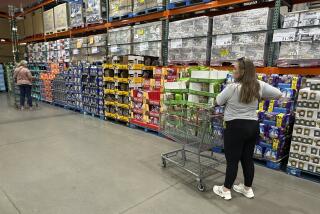Personal Income Marks Time, but Home Sales Soar
- Share via
WASHINGTON — Americans’ personal income stagnated in June, raising the question of whether they’ll be able to spend enough to keep the economy improving.
So far, they’re managing--personal spending was up 0.6% for the month and new home sales jumped 11%.
But “the bottom line is, this can’t last,” said economist Donald H. Straszheim of Merrill Lynch.
Personal income was unchanged at a seasonally adjusted annual rate of $5.3 trillion, breaking a string of six consecutive increases, the Commerce Department said Friday.
In a separate report, the Housing and Commerce departments said new home sales surged 11% to a seasonally adjusted annual rate of 678,000, the second-largest total since October, 1989. However, that followed a 12.5% drop in May.
In June, sales rose everywhere except the West. In the South, they soared 33.6% to the highest level since June, 1986.
The combination last month of relatively brisk consumer spending and no income growth depressed Americans’ savings rate--savings as a percentage of after-tax income--to 3.9%. That was the lowest since October, 1990 and down from 4.6% the month before.
“We’ve seen several months now with not much income growth and still halfway decent increases in spending,” Straszheim said. “The net result is people are spending increasingly out of savings. That’s not a sustainable process. What’s necessary is for employment to pick up.”
However, the nation’s unemployment rate has remained stuck at 7% virtually all year and economists expect any improvement to be painfully slow.
“Consumer incomes are rising very slowly and there seems to be nothing around to change that,” said economist Sandra Shaber of the WEFA Group, a forecasting firm in Bala Cynwyd, Pa.
Income last failed to increase in November, when it also was unchanged. It had risen 0.5% in May and 0.2% in April. Spending, which reached a seasonally adjusted annual rate of $4.32 trillion in June, had posted gains of 0.4% in May and 1.3% in April.
“The big increase in spending in the second quarter can’t be sustained,” she said.
The most-watched component of income--wages and salaries--slipped 0.1% in June following a 1% gain the month before.
Business owners’ and rental income also rose in June, as did government transfer payments such as unemployment benefits. Interest income, however, fell and tax payments rose.
Real disposable income--inflation-adjusted income after taxes--fell 0.1% after a 0.3% gain in May.
Consumer spending, meanwhile, rose 0.6% for long-lasting durable goods such as cars and appliances. It increased 0.3% for non-durable goods and 0.8% for services.
More to Read
Inside the business of entertainment
The Wide Shot brings you news, analysis and insights on everything from streaming wars to production — and what it all means for the future.
You may occasionally receive promotional content from the Los Angeles Times.










